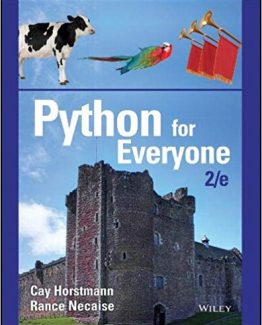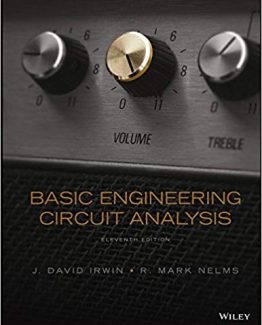Computer Organization and Design MIPS Edition: The Hardware/Software Interface 6th Edition, ISBN-13: 978-0128201091
[PDF eBook eTextbook]
- Publisher: Morgan Kaufmann; 6th edition (December 4, 2020)
- Language: English
- 832 pages
- ISBN-10: 0128201096
- ISBN-13: 978-0128201091
The market-leading title for computer organization courses, with state-of-the art content and a full range of accessible exercises.
Computer Organization and Design: The Hardware/Software Interface, Sixth Edition, the leading, award-winning textbook from Patterson and Hennessy used by more than 40,000 students per year, continues to present the most comprehensive and readable introduction to this core computer science topic. Improvements to this new release include new sections in each chapter on Domain Specific Architectures (DSA) and updates on all real-world examples that keep it fresh and relevant for a new generation of students.
Table of Contents:
Title page
In Praise of Computer Organization and Design: The Hardware/Software
Interface, Sixth Edition
Copyright
Dedication
Preface
About This Book
About the Other Book
Changes for the Sixth Edition
Instructor Support
Concluding Remarks
Acknowledgments for the Sixth Edition
1. Computer Abstractions and Technology
1.1 Introduction
1.2 Seven Great Ideas in Computer Architecture
1.3 Below Your Program
1.4 Under the Covers
1.5 Technologies for Building Processors and Memory
1.6 Performance
1.7 The Power Wall
1.8 The Sea Change: The Switch from Uniprocessors to
Multiprocessors
1.9 Real Stuff: Benchmarking the Intel Core i7
1.10 Going Faster: Matrix Multiply in Python
1.11 Fallacies and Pitfalls
1.12 Concluding Remarks
Historical Perspective and Further Reading
1.13 Historical Perspective and Further Reading
1.14 Self-Study
1.15 Exercises
2. Instructions: Language of the Computer
2.1 Introduction
2.2 Operations of the Computer Hardware
2.3 Operands of the Computer Hardware
2.4 Signed and Unsigned Numbers
2.5 Representing Instructions in the Computer
2.6 Logical Operations
2.7 Instructions for Making Decisions
2.8 Supporting Procedures in Computer Hardware
2.9 Communicating with People
2.10 MIPS Addressing for 32-bit Immediates and Addresses
2.11 Parallelism and Instructions: Synchronization
2.12 Translating and Starting a Program
2.13 A C Sort Example to Put It All Together
2.14 Arrays versus Pointers
Advanced Material: Compiling C and Interpreting Java
2.15 Advanced Material: Compiling C and Interpreting Java
2.16 Real Stuff: ARMv7 (32-bit) Instructions
2.17 Real Stuff: ARMv8 (64-bit) Instructions
2.18 Real Stuff: RISC-V Instructions
2.19 Real Stuff: x86 Instructions
2.20 Going Faster: Matrix Multiply in C
2.21 Fallacies and Pitfalls
2.22 Concluding Remarks
Historical Perspective and Further Reading
2.21 Historical Perspective and Further Reading
2.24 Self-Study
2.25 Exercises
3. Arithmetic for Computers
3.1 Introduction
3.2 Addition and Subtraction
3.3 Multiplication
3.4 Division
3.5 Floating Point
3.6 Parallelism and Computer Arithmetic: Subword Parallelism
3.7 Real Stuff: Streaming SIMD Extensions and Advanced
Vector Extensions in x86
3.8 Going Faster: Subword Parallelism and Matrix Multiply
3.9 Fallacies and Pitfalls
3.10 Concluding Remarks
Historical Perspective and Further Reading
3.11 Historical Perspective and Further Reading
3.12 Self-Study
3.13 Exercises
4. The Processor
4.1 Introduction
4.2 Logic Design Conventions
4.3 Building a Datapath
4.4 A Simple Implementation Scheme
A Multicycle Implementation
4.5 A Multicycle Implementation
4.6 An Overview of Pipelining
4.7 Pipelined Datapath and Control
4.8 Data Hazards: Forwarding versus Stalling
4.9 Control Hazards
4.10 Exceptions
4.11 Parallelism via Instructions
4.12 Putting It All Together: The Intel Core i7 6700 and ARM
Cortex-A53
The ARM Cortex-A53
Performance of the A53 Pipeline
The Intel Core i7 6700
Performance of the i7
4.13 Going Faster: Instruction-Level Parallelism and Matrix
Multiply
Advanced Topic: an Introduction to Digital Design Using a
Hardware Design Language to Describe and Model a Pipeline
and More Pipelining Illustrations
4.14 An Introduction to Digital Design Using a Hardware Design
Language to Describe and Model a Pipeline and More Pipelining
Illustrations
4.15 Fallacies and Pitfalls
4.16 Concluding Remarks
Historical Perspective and Further Reading
4.17 Historical Perspective and Further Reading
4.18 Self Study
Self-Study Answers
4.19 Exercises
5. Large and Fast: Exploiting Memory Hierarchy
5.1 Introduction
5.2 Memory Technologies
5.3 The Basics of Caches
5.4 Measuring and Improving Cache Performance
5.5 Dependable Memory Hierarchy
5.6 Virtual Machines
5.7 Virtual Memory
5.8 A Common Framework for Memory Hierarchy
5.9 Using a Finite-State Machine to Control a Simple Cache
5.10 Parallelism and Memory Hierarchy: Cache Coherence
Parallelism and Memory Hierarchy: Redundant Arrays of
Inexpensive Disks
5.11 Parallelism and the Memory Hierarchy: Redundant Arrays
of Inexpensive Disks
Advanced Material: Implementing Cache Controllers
5.12 Advanced Material: Implementing Cache Controllers
5.13 Real Stuff: The ARM Cortex-A8 and Intel Core i7 Memory
Hierarchies
Performance of the Cortex-A53 and Core i7 Memory Hierarchies
5.14 Going Faster: Cache Blocking and Matrix Multiply
5.15 Fallacies and Pitfalls
5.16 Concluding Remarks
Historical Perspective and Further Reading
5.17 Historical Perspective and Further Reading
5.18 Self-Study
Self-Study Answers
5.19 Exercises
6. Parallel Processors from Client to Cloud
6.1 Introduction
6.2 The Difficulty of Creating Parallel Processing Programs
6.3 SISD, MIMD, SIMD, SPMD, and Vector
6.4 Hardware Multithreading
6.5 Multicore and Other Shared Memory Multiprocessors
6.6 Introduction to Graphics Processing Units
6.7 Domain Specific Architectures
6.8 Clusters, Warehouse Scale Computers, and Other
Message-Passing Multiprocessors
6.9 Introduction to Multiprocessor Network Topologies
Communicating to the Outside World: Cluster Networking
6.10 Communicating to the Outside World: Cluster Networking
6.11 Multiprocessor Benchmarks and Performance Models
6.12 Real Stuff: Benchmarking the Google TPUv3
Supercomputer and an NVIDIA Volta GPU Cluster
6.13 Going Faster: Multiple Processors and Matrix Multiply
6.14 Fallacies and Pitfalls
6.15 Concluding Remarks
Historical Perspective and Further Reading
6.16 Historical Perspective and Further Reading
6.17 Self-Study
Answers to Self-Study
6.18 Exercises
Appendices
Appendix A. Assemblers, Linkers, and the SPIM Simulator
A.1 Introduction
A.2 Assemblers
A.3 Linkers
A.4 Loading
A.5 Memory Usage
A.6 Procedure Call Convention
A.7 Exceptions and Interrupts
A.8 Input and Output
A.9 SPIM
A.10 MIPS R2000 Assembly Language
A.11 Concluding Remarks
A.12 Exercises
Further Reading
Appendix B. The Basics of Logic Design
B.1 Introduction
B.2 Gates, Truth Tables, and Logic Equations
B.3 Combinational Logic
B.4 Using a Hardware Description Language
B.5 Constructing a Basic Arithmetic Logic Unit
B.6 Faster Addition: Carry Lookahead
B.7 Clocks
B.8 Memory Elements: Flip-Flops, Latches, and Registers
B.9 Memory Elements: SRAMs and DRAMs
B.10 Finite-State Machines
B.11 Timing Methodologies
B.12 Field Programmable Devices
B.13 Concluding Remarks
B.14 Exercises
Further Reading
Appendix C. Graphics and Computing GPUs
C.1 Introduction
C.2 GPU System Architectures
C.3 Programming GPUs
C.4 Multithreaded Multiprocessor Architecture
C.5 Parallel Memory System
C.6 Floating-point Arithmetic
C.7 Real Stuff: The NVIDIA GeForce 8800
C.8 Real Stuff: Mapping Applications to GPUs
C.9 Fallacies and Pitfalls
C.10 Concluding Remarks
C.11 Historical Perspective and Further Reading
Further Reading
Appendix D. Mapping Control to Hardware
D.1 Introduction
D.2 Implementing Combinational Control Units
D.3 Implementing Finite-State Machine Control
D.4 Implementing the Next-State Function with a Sequencer
D.5 Translating a Microprogram to Hardware
D.6 Concluding Remarks
D.7 Exercises
Appendix E. Survey of Instruction Set Architectures
E.1 Introduction
E.2 A Survey of RISC Architectures for Desktop, Server, and
Embedded Computers
E.3 The Intel 80×86
E.4 The VAX Architecture
E.5 The IBM 360/370 Architecture for Mainframe Computers
E.6 Historical Perspective and References
Glossary
Further Reading
Index
MIPS Reference Data Card (“Green Card”)
ACM named David A. Patterson a recipient of the 2017 ACM A.M. Turing Award for pioneering a systematic, quantitative approach to the design and evaluation of computer architectures with enduring impact on the microprocessor industry. David A. Patterson is the Pardee Chair of Computer Science, Emeritus at the University of California Berkeley. His teaching has been honored by the Distinguished Teaching Award from the University of California, the Karlstrom Award from ACM, and the Mulligan Education Medal and Undergraduate Teaching Award from IEEE. Patterson received the IEEE Technical Achievement Award and the ACM Eckert-Mauchly Award for contributions to RISC, and he shared the IEEE Johnson Information Storage Award for contributions to RAID. He also shared the IEEE John von Neumann Medal and the C & C Prize with John Hennessy. Like his co-author, Patterson is a Fellow of the American Academy of Arts and Sciences, the Computer History Museum, ACM, and IEEE, and he was elected to the National Academy of Engineering, the National Academy of Sciences, and the Silicon Valley Engineering Hall of Fame. He served on the Information Technology Advisory Committee to the U.S. President, as chair of the CS division in the Berkeley EECS department, as chair of the Computing Research Association, and as President of ACM. This record led to Distinguished Service Awards from ACM, CRA, and SIGARCH.
ACM named John L. Hennessy a recipient of the 2017 ACM A.M. Turing Award for pioneering a systematic, quantitative approach to the design and evaluation of computer architectures with enduring impact on the microprocessor industry. John L. Hennessy is a Professor of Electrical Engineering and Computer Science at Stanford University, where he has been a member of the faculty since 1977 and was, from 2000 to 2016, its tenth President. Prof. Hennessy is a Fellow of the IEEE and ACM; a member of the National Academy of Engineering, the National Academy of Science, and the American Philosophical Society; and a Fellow of the American Academy of Arts and Sciences. Among his many awards are the 2001 Eckert-Mauchly Award for his contributions to RISC technology, the 2001 Seymour Cray Computer Engineering Award, and the 2000 John von Neumann Award, which he shared with David Patterson. He has also received seven honorary doctorates.
What makes us different?
• Instant Download
• Always Competitive Pricing
• 100% Privacy
• FREE Sample Available
• 24-7 LIVE Customer Support






Reviews
There are no reviews yet.